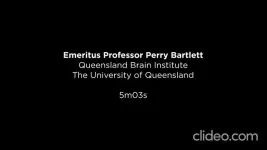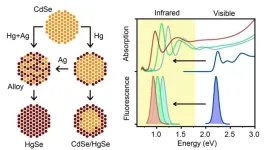(Press-News.org) A longitudinal study by University of Queensland researchers has found high-intensity interval exercise improves brain function in older adults for up to 5 years.
Emeritus Professor Perry Bartlett and Dr Daniel Blackmore from UQ’s Queensland Brain Institute led the study in which volunteers did physical exercise and had brain scans.
Emeritus Professor Perry Bartlett and Dr Daniel Blackmore have shown high intensity exercise boosts cognition in healthy older adults and the improvement was retained for up to 5 years.
Emeritus Professor Bartlett said it is the first controlled study of its kind to show exercise can boost cognition in healthy older adults not just delay cognitive decline.
“Six months of high-intensity interval training is enough to flick the switch,” Emeritus Professor Bartlett said.
“In earlier pre-clinical work , we discovered exercise can activate stem cells and increase the production of neurons in the hippocampus, improving cognition.
“In this study, a large cohort of healthy 65 – 85-year-old volunteers joined a six-month exercise program, did biomarker and cognition testing and had high-resolution brain scans.
“We followed up with them 5 years after the program and incredibly they still had improved cognition, even if they hadn’t kept up with the exercises.”
Ageing is one of the biggest risks for dementia, a condition that affects almost half a million Australians.
“If we can change the trajectory of ageing and keep people cognitively healthier for longer with a simple intervention like exercise, we can potentially save our community from the enormous personal, economic and social costs associated with dementia,” Emeritus Professor Bartlett said.
Emeritus Professor Bartlett and Dr Blackmore worked in collaboration with Honorary Professor Stephan Riek and The School of Human Movement and Nutrition Sciences at UQ.
During the study, the researchers assessed the impact of three exercise intensities:
• Low – predominantly motor function, balance and stretching
• Medium – brisk walking on a treadmill
• High – four cycles running on a treadmill at near maximum exertion
Dr Blackmore said only the high-intensity interval exercise led to cognitive improvement that was retained for up to 5 years.
"On high-resolution MRI scans of that group, we saw structural and connectivity changes in the hippocampus, the area responsible for learning and memory,” Dr Blackmore said.
“We also found blood biomarkers that changed in correlation to improvements in cognition.
“Biomarkers can be useful in predicting the effectiveness of the exercise a person is doing.”
With 1 in 3 people aged 85 years likely to develop dementia, Dr Blackmore said the impact of the research was far-reaching.
“Our finding can inform exercise guidelines for older people and further research could assess different types of exercise that could be incorporated into aged care,” he said.
"We are now looking at the genetic factors that may regulate a person’s response to exercise to see if we can establish who will and who will not respond to this intervention.
“The use of biomarkers as a diagnostic tool for exercise also needs further research.”
The research was published in Aging and Disease.
It receives ongoing support from the Stafford Fox Medical Research Foundation.
Media:
QBI Communications, communications@qbi.uq.edu.au, Merrett Pye +61 422 096 049; Elaine Pye +61 415 222 606.
END
UQ research reveals exercise brain boost can last for years
High-intensity interval exercise improves brain function in older adults for up to 5 years
2024-07-10
ELSE PRESS RELEASES FROM THIS DATE:
Researchers identify brain region involved in oxycodone relapse
2024-07-10
LA JOLLA, CA—Even years after they have recovered, a person who once struggled with alcohol or opioid addiction can relapse—and that relapse is more likely to occur during particularly stressful times. Now, Scripps Research scientists have identified an area of the brain that plays a key role in stress-induced oxycodone relapse. Their findings explain why the drug suvorexant, which they previously found to reduce alcohol and oxycodone relapse when administered orally, works so well.
“Having a better understanding of the region(s) in the brain responsible for this kind of relapse is incredibly important as we develop treatments for alcohol use disorder and opioid ...
Daily sugar intake fell by 5 g in kids + 11 g in adults year after UK sugar tax imposition
2024-07-10
Daily sugar intake fell by around 5 g in children and by around 11 g in adults in the 12 months following the introduction of the UK’s ‘sugar tax’, formally known as the Soft Drinks Industry Levy, finds an analysis of 11 years of survey data, published online in the Journal of Epidemiology & Community Health.
The sugar from soft drinks alone made up over half this total, the estimates suggest. But overall daily energy intake from free sugars levels are still higher than the updated recommendation from the World Health Organisation (WHO) of 5%---equivalent to 30 g/day for adults, 24 g for 7–10 year olds, and 19 g for 4–6 year olds—point ...
Osteoarthritis may double risk of speedy progression to severe multimorbidity
2024-07-10
Osteoarthritis—a condition in which the protective cartilage on the ends of bones breaks down—may more than double the risk of speedy progression to accumulating severe long term conditions (multimorbidity), finds a 20 year study published in the open access journal RMD Open.
And there seem to be 4 different speeds of progression to multimorbidity, the findings indicate.
Persistently low levels of physical activity, a high calorie diet, plus chronic low grade inflammation may help to explain the link between osteoarthritis and the risk of accumulating other long term conditions, suggest the researchers.
Although the exact causes aren’t known, injury, age, family ...
Researchers listen to the hearts of bats in flight
2024-07-10
Researchers from Konstanz have measured the heart rate of bats over several days in the wild, including complete flights—the first time this has been done for a bat species. To record the heart rate of male common noctule bats during flight, the scientists attached heart rate transmitters weighing less than one gram to the animals, which they then accompanied in an airplane while the bats flew, sometimes for more than an hour, in search of food. Their results, published in Proceedings of the Royal Society B, show how much energy bats consume over the course of a day and what energy-saving strategies they ...
Familial endocrine diseases linked to increased risk of pregnancy loss, new research shows
2024-07-10
Women who have close family members with endocrine diseases, including type 2 diabetes, thyroid diseases and polycystic ovary syndrome (PCOS), are at higher risk of pregnancy loss, a new study has found [1].
The research, presented today at the ESHRE 40th Annual Meeting in Amsterdam, examined the association between various endocrine diseases and the incidence of pregnancy loss. The study investigated 366,539 women in Denmark between 1973 and 2022.
The study found that women with parents diagnosed with endocrine diseases faced a 6% higher risk of pregnancy loss ...
Health AI expert Nathan Price joins Buck faculty
2024-07-09
The Buck Institute for Research on Aging announces the appointment of Nathan Price, PhD, to Professor and Co-Director of the Center for Human Healthspan. Price specializes in systems biology, artificial intelligence, and bioengineering. He has published more than 200 scientific papers and is co-author, with Buck Chief Innovation Officer and Distinguished Professor Lee Hood, of “The Age of Scientific Wellness.” Price has been named one of 10 Emerging Leaders in Health and Medicine by the National Academy of Medicine and is a member of the Board on Life Sciences of the National Academies of Sciences, Engineering, and Medicine.
Dr. Price is Chief Scientific Officer ...
Greater focus needed on how existing international law can prevent the increasing militarisation of outer space
2024-07-09
There is a pressing need for countries and international organisations to understand better how existing international law can help them address serious concerns about the militarisation of outer space, a new study says.
Space ...
Found with Webb: a potentially habitable icy world
2024-07-09
A international team of astronomers led by Université de Montréal has made an exciting discovery about the temperate exoplanet LHS 1140 b: it could be a promising "super-Earth" covered in ice or water.
When the exoplanet LHS 1140 b was first discovered, astronomers speculated that it might be a mini-Neptune: an essentially gaseous planet, but very small in size compared to Neptune. But after analyzing data from the James Webb Space Telescope (JWST) collected in December 2023 - combined with previous data from other space telescopes such as Spitzer, Hubble and ...
New one-step method to make multiple edits to a cell’s genome
2024-07-09
SAN FRANCISCO, CA—Genome editing has become a widely adopted technology to modify DNA in cells, allowing scientists to study diseases in the lab and develop therapies that repair disease-causing mutations. However, with current approaches, it’s only possible to edit cells in one location at a time.
Now, a team of scientists at Gladstone Institutes has developed a new method that enables them to make precise edits in multiple locations within a cell—all at once. Using molecules called retrons, they created a tool that can efficiently modify DNA in bacteria, yeast, and human cells.
“We wanted to push the boundaries of genomic technologies ...
Moving from the visible to the infrared: Developing high quality nanocrystals
2024-07-09
Awarded the 2023 Nobel Prize in Chemistry, quantum dots have a wide variety of applications ranging from displays and LED lights to chemical reaction catalysis and bioimaging. These semiconductor nanocrystals are so small—on the order of nanometers—that their properties, such as color, are size dependent, and they start to exhibit quantum properties. This technology has been really well developed, but only in the visible spectrum, leaving untapped opportunities for technologies in both the ultraviolet and infrared regions of the electromagnetic ...
LAST 30 PRESS RELEASES:
Injectable breast ‘implant’ offers alternative to traditional surgeries
Neuroscientists devise formulas to measure multilingualism
New prostate cancer trial seeks to reduce toxicity without sacrificing efficacy
Geometry shapes life
A CRISPR screen reveals many previously unrecognized genes required for brain development and a new neurodevelopmental disorder
Hot flush treatment has anti-breast cancer activity, study finds
Securing AI systems against growing cybersecurity threats
Longest observation of an active solar region
Why nail-biting, procrastination and other self-sabotaging behaviors are rooted in survival instincts
Regional variations in mechanical properties of porcine leptomeninges
Artificial empathy in therapy and healthcare: advancements in interpersonal interaction technologies
Why some brains switch gears more efficiently than others
UVA’s Jundong Li wins ICDM’S 2025 Tao Li Award for data mining, machine learning
UVA’s low-power, high-performance computer power player Mircea Stan earns National Academy of Inventors fellowship
Not playing by the rules: USU researcher explores filamentous algae dynamics in rivers
Do our body clocks influence our risk of dementia?
Anthropologists offer new evidence of bipedalism in long-debated fossil discovery
Safer receipt paper from wood
Dosage-sensitive genes suggest no whole-genome duplications in ancestral angiosperm
First ancient human herpesvirus genomes document their deep history with humans
Why Some Bacteria Survive Antibiotics and How to Stop Them - New study reveals that bacteria can survive antibiotic treatment through two fundamentally different “shutdown modes”
UCLA study links scar healing to dangerous placenta condition
CHANGE-seq-BE finds off-target changes in the genome from base editors
The Journal of Nuclear Medicine Ahead-of-Print Tip Sheet: January 2, 2026
Delayed or absent first dose of measles, mumps, and rubella vaccination
Trends in US preterm birth rates by household income and race and ethnicity
Study identifies potential biomarker linked to progression and brain inflammation in multiple sclerosis
Many mothers in Norway do not show up for postnatal check-ups
Researchers want to find out why quick clay is so unstable
Superradiant spins show teamwork at the quantum scale
[Press-News.org] UQ research reveals exercise brain boost can last for yearsHigh-intensity interval exercise improves brain function in older adults for up to 5 years






